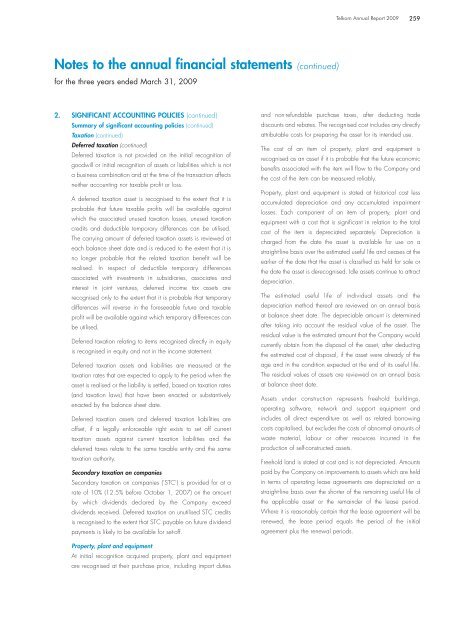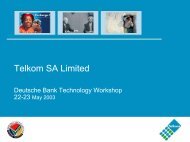Telkom AR front.qxp
Telkom AR front.qxp
Telkom AR front.qxp
You also want an ePaper? Increase the reach of your titles
YUMPU automatically turns print PDFs into web optimized ePapers that Google loves.
Notes to the annual financial statements (continued)<br />
for the three years ended March 31, 2009<br />
2. SIGNIFICANT ACCOUNTING POLICIES (continued)<br />
Summary of significant accounting policies (continued)<br />
Taxation (continued)<br />
Deferred taxation (continued)<br />
Deferred taxation is not provided on the initial recognition of<br />
goodwill or initial recognition of assets or liabilities which is not<br />
a business combination and at the time of the transaction affects<br />
neither accounting nor taxable profit or loss.<br />
A deferred taxation asset is recognised to the extent that it is<br />
probable that future taxable profits will be available against<br />
which the associated unused taxation losses, unused taxation<br />
credits and deductible temporary differences can be utilised.<br />
The carrying amount of deferred taxation assets is reviewed at<br />
each balance sheet date and is reduced to the extent that it is<br />
no longer probable that the related taxation benefit will be<br />
realised. In respect of deductible temporary differences<br />
associated with investments in subsidiaries, associates and<br />
interest in joint ventures, deferred income tax assets are<br />
recognised only to the extent that it is probable that temporary<br />
differences will reverse in the foreseeable future and taxable<br />
profit will be available against which temporary differences can<br />
be utilised.<br />
Deferred taxation relating to items recognised directly in equity<br />
is recognised in equity and not in the income statement.<br />
Deferred taxation assets and liabilities are measured at the<br />
taxation rates that are expected to apply to the period when the<br />
asset is realised or the liability is settled, based on taxation rates<br />
(and taxation laws) that have been enacted or substantively<br />
enacted by the balance sheet date.<br />
Deferred taxation assets and deferred taxation liabilities are<br />
offset, if a legally enforceable right exists to set off current<br />
taxation assets against current taxation liabilities and the<br />
deferred taxes relate to the same taxable entity and the same<br />
taxation authority.<br />
Secondary taxation on companies<br />
Secondary taxation on companies (’STC’) is provided for at a<br />
rate of 10% (12.5% before October 1, 2007) on the amount<br />
by which dividends declared by the Company exceed<br />
dividends received. Deferred taxation on unutilised STC credits<br />
is recognised to the extent that STC payable on future dividend<br />
payments is likely to be available for set-off.<br />
Property, plant and equipment<br />
At initial recognition acquired property, plant and equipment<br />
are recognised at their purchase price, including import duties<br />
<strong>Telkom</strong> Annual Report 2009 259<br />
and non-refundable purchase taxes, after deducting trade<br />
discounts and rebates. The recognised cost includes any directly<br />
attributable costs for preparing the asset for its intended use.<br />
The cost of an item of property, plant and equipment is<br />
recognised as an asset if it is probable that the future economic<br />
benefits associated with the item will flow to the Company and<br />
the cost of the item can be measured reliably.<br />
Property, plant and equipment is stated at historical cost less<br />
accumulated depreciation and any accumulated impairment<br />
losses. Each component of an item of property, plant and<br />
equipment with a cost that is significant in relation to the total<br />
cost of the item is depreciated separately. Depreciation is<br />
charged from the date the asset is available for use on a<br />
straight-line basis over the estimated useful life and ceases at the<br />
earlier of the date that the asset is classified as held for sale or<br />
the date the asset is derecognised. Idle assets continue to attract<br />
depreciation.<br />
The estimated useful life of individual assets and the<br />
depreciation method thereof are reviewed on an annual basis<br />
at balance sheet date. The depreciable amount is determined<br />
after taking into account the residual value of the asset. The<br />
residual value is the estimated amount that the Company would<br />
currently obtain from the disposal of the asset, after deducting<br />
the estimated cost of disposal, if the asset were already of the<br />
age and in the condition expected at the end of its useful life.<br />
The residual values of assets are reviewed on an annual basis<br />
at balance sheet date.<br />
Assets under construction represents freehold buildings,<br />
operating software, network and support equipment and<br />
includes all direct expenditure as well as related borrowing<br />
costs capitalised, but excludes the costs of abnormal amounts of<br />
waste material, labour or other resources incurred in the<br />
production of self-constructed assets.<br />
Freehold land is stated at cost and is not depreciated. Amounts<br />
paid by the Company on improvements to assets which are held<br />
in terms of operating lease agreements are depreciated on a<br />
straight-line basis over the shorter of the remaining useful life of<br />
the applicable asset or the remainder of the lease period.<br />
Where it is reasonably certain that the lease agreement will be<br />
renewed, the lease period equals the period of the initial<br />
agreement plus the renewal periods.




